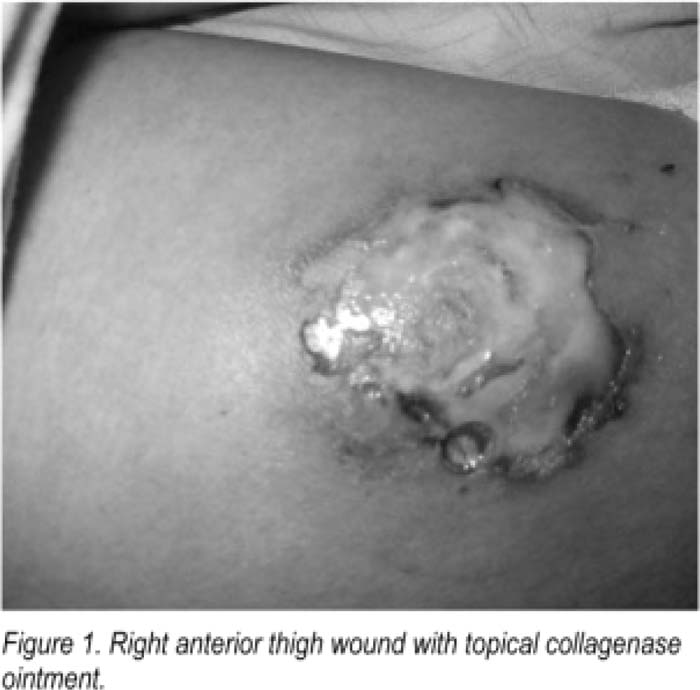Case Presentation:
A 28‐year‐old with a supratentorial primitive neuroectodermal tumor treated with resection and chemutlkerepy was admitted for a thigh wound. She had recently been hospitelized for declining mental slatus and was found to have tumor enlargement with cerebral edema and midline shift. This was responsive to high‐dose decadron, and she was discharged to a rehabilitation facility. During her 2 weeks at the rehabilitation facility, she developed a small painful thigh wound that progressively enlarged. She was seen by infectious disease and treated with imipenem based on superficial wound culture results. She was Transferred to our institution for PICC line insertion because of concems about low platelet counts. On admission, she was afebrile and her vital signs were within normal limits. The lesion was a 10 cm indurated circular area on her anterior right thigh with surrounding erythema and a central 7 cm dry ulceration with a necrotic rim (Fig. 1). A CBC showed a WBC count of 2900 with an absolute neutrophil count of 2400. Her platelets were 23,000. A CT of the region showed subcutaneous extension of the wound with no abscess or muscular invasion. Imipenem was switched to vancomycin and piperacillin-tazobactam to treat bacterial infection and dermatology was consulted. A biopsy was obtained which revealed thick, nonseptated hyphae branching at right angles consistent with rhizopus infection. Treatment with amphotericin was initiated, and plastic surgery performed a wide excision to clean margins.
Discussion:
The overwhelming majority of cutaneous infections are bacterial in origin — Staph and Strep spp. Therefore, initial treatment with antibiotics covering these organisms is appropriate. Mucormycosis is an uncommon and potentially fatal infection. Inoculation occurs by spore inhalation, ingestion, or percutaneous traumatic implantation. Site of infection by incidence include sinus (39%), pulmonary (24%), cutaneous (19%), cerebral (9%), gastrointestinal (7%), and other (9%). Zygomycetes predominantly infect patients with compromised immune systems from diabetes (36%). malignancy (17%), solid organ transplantation (7%), and deferoxamine therapy (6%) with immunocompetent patients only accounting for 19% of all cases. Treatment consists of surgical excision and anti‐fungal therapy with amphotericin. Despite therapy, mortality rates still range between 57% and 85%.
Conclusions:
Cutaneous mucormycosis is an uncommon skin infection in a patient on high‐dose steroids. However, in the immunocompromised patient, failure to respond to initial therapy should quickly be readdressed. In general, hospitalisls can apply Occam's razor to patient care in that the simplest diagnosis and treatment fits. However, this often does not apply to the immunocompromised patient.
Author Disclosure:
L. Goldenstein, none; P. Das, none; N. Theodoropoulos, none; M. Mirzabeigi, none; S. Rohan, none; J. Barsuk, none.

